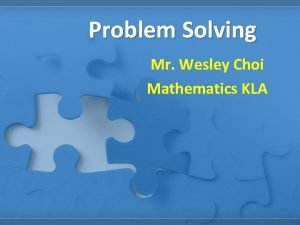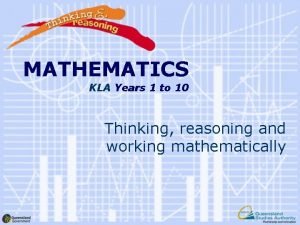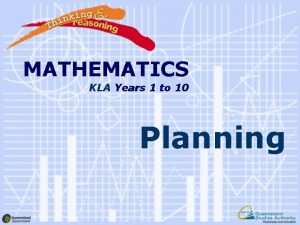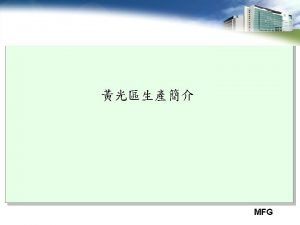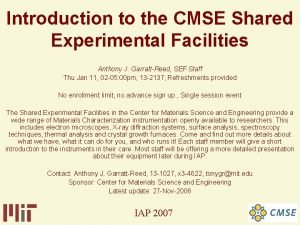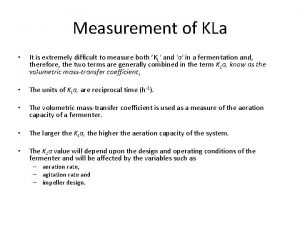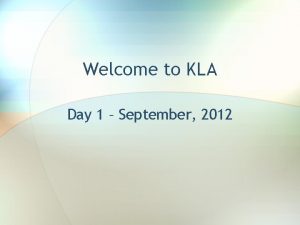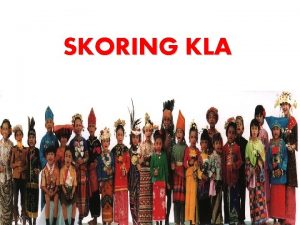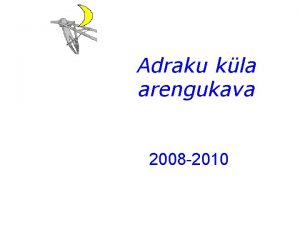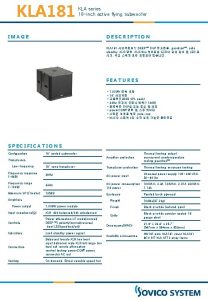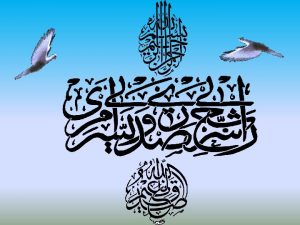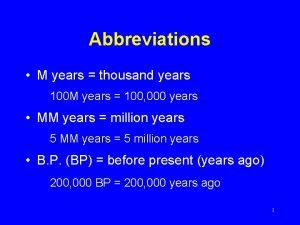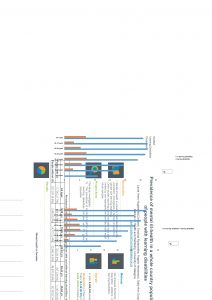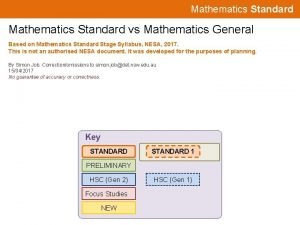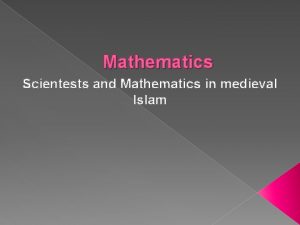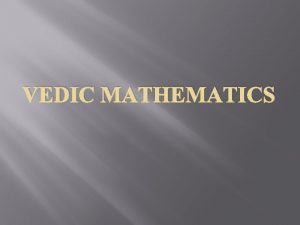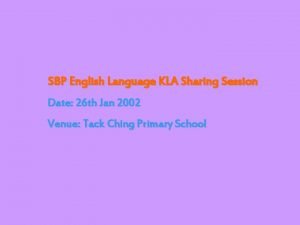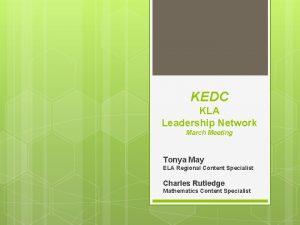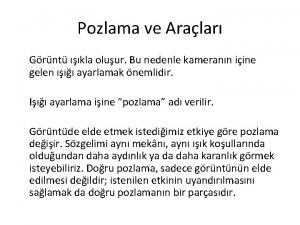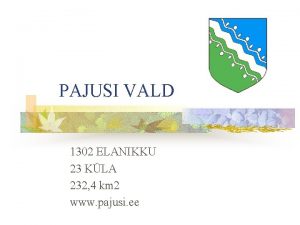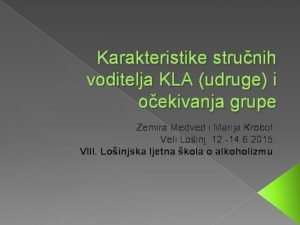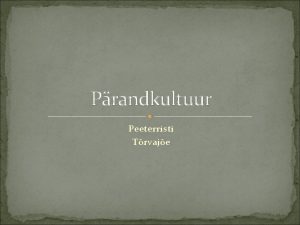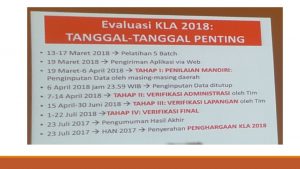MATHEMATICS KLA Years 1 to 10 Understanding the











































- Slides: 43

MATHEMATICS KLA Years 1 to 10 Understanding the syllabus

The Years 1 to 10 Mathematics Syllabus § is based on current research into mathematics education § reflects current national and international best practice § replaces and builds on the 1987 Years 1 to 10 Mathematics syllabus.

The syllabus has links to § Early Years Curriculum Guidelines § Year 2 Diagnostic Net § Queensland Years 3, 5 and 7 testing programs § national numeracy benchmarks Years 3, 5 and 7 § senior secondary syllabuses.

Structure The syllabus is organised into sections: § § rationale outcomes assessment reporting.

Rationale § emphasises the importance of providing opportunities for students to think, reason and work mathematically § highlights how mathematics helps individuals make meaning of their world § describes how the language of mathematics enables communication.

Thinking, reasoning and working mathematically § is the underlying premise on which the Years 1 to 10 Mathematics Syllabus has been developed § is promoted through engagement in mathematical investigations.

Positive dispositions towards mathematics learning are integral to thinking, reasoning and working mathematically.

Students think, reason and work mathematically when they § see the mathematics in situations encountered.

Students think, reason and work mathematically when they § plan, investigate, conjecture, justify, think critically, generalise, communicate and reflect on mathematical understandings and procedures.

Students think, reason and work mathematically when they § select and use relevant mathematical knowledge, procedures, strategies and technologies to analyse and interpret information.

Mathematical knowledge includes § knowing about mathematics § knowing how to do mathematics § and knowing when and where to use mathematics.

An outcomes approach § The Years 1 to 10 Mathematics Syllabus is based on an outcomes approach.

Principles underpinning an outcomes approach § § a clear focus on learning outcomes high expectations for all students a focus on development planning curriculum with learners and outcomes in mind § expanded opportunities to learn.

Outcomes There is a hierarchy of outcomes in the syllabus: § overall learning outcomes § key learning area outcomes § core, discretionary and Foundation Level learning outcomes.

Overall learning outcomes § are common to all key learning areas § assist students to become lifelong learners, achieve their potential and play active roles in their family and work lives § are the outcomes expected both during, and as a result of, learning experiences throughout the 10 years of the common curriculum.

A lifelong learner is § a knowledgeable person with deep understanding § a complex thinker § a responsive creator § an active investigator § an effective communicator § a participant in an interdependent world § a reflective and self-directed learner.

Key learning area outcomes § are the intended results of extended engagement with the Years 1 to 10 Mathematics key learning area § are the ‘big picture’ outcomes for Mathematics across Years 1 to 10.

Level statements § are included for each level of each strand of the syllabus § summarise learning outcomes at each level and provide the conceptual framework for developing the learning outcomes.

Core learning outcomes § describe learnings considered essential for all students § describe what students should know and be able to do with what they know § are sequenced across Levels 1 to 6 § are presented in levels of increasing complexity and sophistication § provide the focus for planning for learning and teaching.

Level 1 Level 2 Level 3 Level 4 Level 5 Level 6 The sequencing of the learning outcomes based on each topic is such that each level is ‘nested’ within the following level.

Foundation Level learning outcomes § are examples of outcomes for students with disabilities. Foundation Level outcomes could also be developed by teachers to meet the needs and interests of individual students or groups of students.

Discretionary learning outcomes § describe learnings beyond what are considered essential § are included in the Years 1 to 10 Mathematics Syllabus at Beyond Level 6 § are linked with learnings identified in senior syllabus documents.

Mathematics key learning area Five strands are used to organise the Mathematics key learning area: § Number (N) § Patterns and Algebra (PA) § Measurement (M) § Chance and Data (CD) § Space (S)

Topics § identify the key aspects of mathematics within each strand § are interconnected within the strands § are coded to aid identification. For example, CD 3. 2 identifies Chance and Data strand, core learning outcome Level 3, topic 2 — Data.

Number strand Topics: § Number concepts § Addition and subtraction § Multiplication and division N_. 1 N_. 2 N_. 3

Key emphases of Number strand are § the language and conventions associated with number § different representations of numbers § links between the four operations based on the knowledge of each operation § mental strategies for calculations of exact and approximate answers § money conventions, financial literacy and factors influencing decisions.

Patterns and Algebra strand Topics: § Patterns and functions § Equivalence and equations PA_. 1 PA_. 2

Key emphases of Patterns and Algebra strand are § the language and conventions associated with patterns and algebra § backtracking, equivalence and balance § interpretation of relationships through different representations of functions § strategies and methods for solving equations § links between, and use of, the four operations when solving equations.

Measurement strand Topics: § Length, mass, area and volume § Time M_. 1 M_. 2

Key emphases of Measurement strand are § § the language and conventions of measurement strategies for comparing different measurements skills for measuring relationships between units of measure and between the dimensions formulae § conversion of measurements into manageable forms when calculating § time-management skills.

Chance and Data strand Topics: § Chance § Data CD_. 1 CD_. 2

Key emphases of Chance and Data strand are § the language and conventions of chance and data § data collection methods and displays appropriate for a range of purposes § selection of strategies for situations involving probability and statistics § application of strategies to calculate probability and analyse data § interpretations of probabilities and statistics to inform judgments and decisions.

Space strand Topics: § Shape and line S_. 1 § Location, direction and movement S_. 2

Key emphases of Space strand are § the language of, and conventions associated with, space § geometric properties § connections within and between families of shapes § methods to represent orientation and movement, and to construct shapes § visualisation strategies for dynamic spatial reasoning.

Core content § is strand level specific § is organised using subsets of the topics § is used with the core learning outcomes to plan for learning and teaching § should be in a range of contexts.

Assessment Use assessment information to: § provide ongoing feedback about learning to students § inform decision making related to student learning.

For assessment to be effective it should § § § focus on students’ demonstration of learning be comprehensive be valid and reliable take account of individual learners provide opportunities for students to take responsibility for their own learning and for monitoring their own progress § reflect equity principles.

Assessment involves § providing students with opportunities to demonstrate what they know and can do with what they know § gathering and recording evidence of students’ learning § using evidence to make overall judgments about students’ learning.

Reporting § is the process of communicating information and judgments about students’ learning § should provide students and parents/carers with timely and accurate information that they can understand, interpret and use to support student learning.

Information and judgments about student learning are communicated to § students § parents/carers § other professionals.

Support materials § are intended to help teachers develop understandings about the Mathematics key learning area and the syllabus.

Materials to support the syllabus Understanding the syllabus § core learning outcomes table § elaborations Planning § sample investigations § ideas for investigations § planning advice P– 12 links § connections with - senior syllabus documents - Early Years Curriculum - Years 3, 5 and 7 testing program Additional information § annotated bibliography

Contact us Queensland Studies Authority PO Box 307 Spring Hill Queensland 4004 Australia Phone: +61 7 3864 0299 Fax: +61 7 3221 2553 Visit the QSA website at www. qsa. qld. edu. au
 Mathematics kla
Mathematics kla Mathematics kla
Mathematics kla Mathematics kla
Mathematics kla 光 罩
光 罩 Used kla-tencor flx-2320
Used kla-tencor flx-2320 Static gassing out method
Static gassing out method Goat years to human years
Goat years to human years 300 solar years to lunar years
300 solar years to lunar years Four score and seven years meaning
Four score and seven years meaning Tư thế ngồi viết
Tư thế ngồi viết Hình ảnh bộ gõ cơ thể búng tay
Hình ảnh bộ gõ cơ thể búng tay đặc điểm cơ thể của người tối cổ
đặc điểm cơ thể của người tối cổ Cái miệng nó xinh thế chỉ nói điều hay thôi
Cái miệng nó xinh thế chỉ nói điều hay thôi Cách giải mật thư tọa độ
Cách giải mật thư tọa độ ưu thế lai là gì
ưu thế lai là gì Tư thế ngồi viết
Tư thế ngồi viết Chó sói
Chó sói Thẻ vin
Thẻ vin Thể thơ truyền thống
Thể thơ truyền thống Các châu lục và đại dương trên thế giới
Các châu lục và đại dương trên thế giới Từ ngữ thể hiện lòng nhân hậu
Từ ngữ thể hiện lòng nhân hậu Diễn thế sinh thái là
Diễn thế sinh thái là Vẽ hình chiếu vuông góc của vật thể sau
Vẽ hình chiếu vuông góc của vật thể sau Ng-html
Ng-html V. c c
V. c c Làm thế nào để 102-1=99
Làm thế nào để 102-1=99 Bài hát chúa yêu trần thế alleluia
Bài hát chúa yêu trần thế alleluia Hổ đẻ mỗi lứa mấy con
Hổ đẻ mỗi lứa mấy con Lời thề hippocrates
Lời thề hippocrates Tư thế worm breton là gì
Tư thế worm breton là gì đại từ thay thế
đại từ thay thế Quá trình desamine hóa có thể tạo ra
Quá trình desamine hóa có thể tạo ra Công thức tính thế năng
Công thức tính thế năng Thế nào là mạng điện lắp đặt kiểu nổi
Thế nào là mạng điện lắp đặt kiểu nổi Dot
Dot Bổ thể
Bổ thể Vẽ hình chiếu đứng bằng cạnh của vật thể
Vẽ hình chiếu đứng bằng cạnh của vật thể Phản ứng thế ankan
Phản ứng thế ankan Kể tên các môn thể thao
Kể tên các môn thể thao Thiếu nhi thế giới liên hoan
Thiếu nhi thế giới liên hoan Khi nào hổ con có thể sống độc lập
Khi nào hổ con có thể sống độc lập điện thế nghỉ
điện thế nghỉ Thế nào là sự mỏi cơ
Thế nào là sự mỏi cơ Một số thể thơ truyền thống
Một số thể thơ truyền thống
